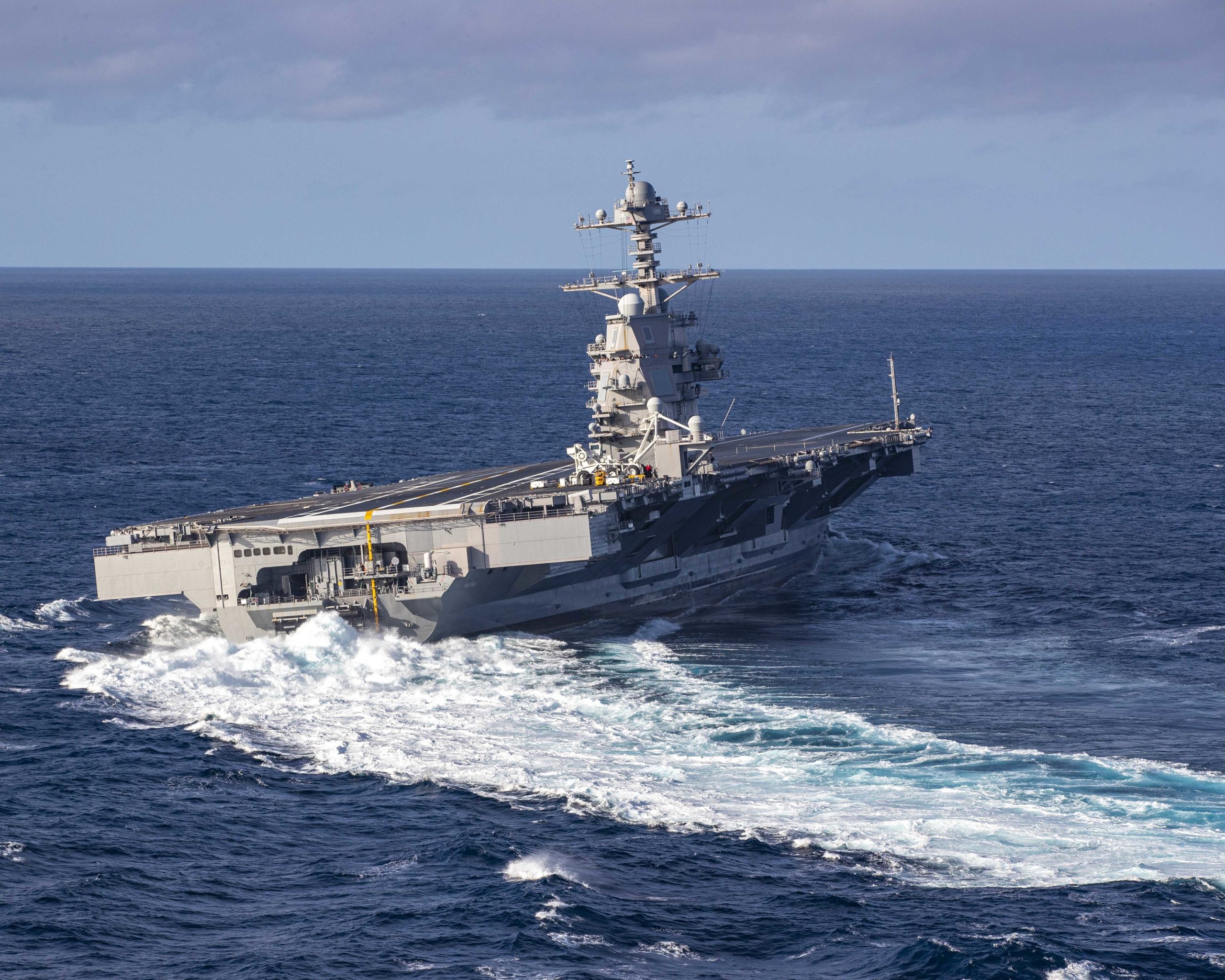China’s new super carrier boasts Ford-class tech
By DAVE MAKICHUKOCTOBER 28, 2021

It’s big, really big.
In fact, recent satellite images show that China’s massive new super carrier is as big as it can be for its drydock.
SAR (Synthetic Aperture Radar) satellites owned by Capella Space have revealed China’s Type-003 — comparable to the US Navy’s advanced Ford Class carrier — is under construction near Shanghai.
According to NavalNews.com, SAR imagery picked out three EMALS (Electro-Magnetic Aircraft Launch System) deck catapults, a major improvement over the Russian based carriers (Liaoning and Shangdong) already in service. The latter rely on a ski-jump bow to launch aircraft.
That means that the KJ-600 AWE&C (Airborne Early Warning And Control) and J-15 Flanker fighters can be operated.
This new twin-prop plane closely resembles the E-2 Hawkeye.
It has a virtually identical layout, to the point that it can casually be referred to as a “copy.”
AEW&C planes can detect and track other aircraft at extreme ranges. This greatly increases the suitability of the carrier, and effectiveness of its combat aircraft, because they can see much further.
Incoming raids or missiles can be detected much further away and the carrier’s air wing can be called to action.
Satellite images of the new plane suggest that the KJ-600 will have a single-faced radar which rotates in a “rotodome” above the fuselage.
The Type-003 is also approximately 80m wide and represents the “full size” Chinese aircraft carrier for the foreseeable future, based on the size of the Shanghai drydock and another gigantic drydock 1,900 km (1,200 miles) further south, at Sanya on Hainan.
That facility is strategically located for access to the South China Sea.
One carrier, the Type-002 Shandong, is already based there, together with most of China’s nuclear submarine fleet.
China has the world’s largest navy and the largest shipbuilding industry, but the Type 003 is the latest step up, The Guardian reported.
It forms part of Beijing’s attempts to push back the US navy in the western Pacific, beyond the first island chain that runs south of Japan, between Taiwan and the Philippines to the South China Sea – the reason why Washington wants to draw far-flung Australia and the UK into the region and the controversial AUKUS defence pact.
“China has been building a capacity over the last two decades to deny the US significant freedom of action in the western Pacific,” said Sidharth Kaushal, a research fellow at the Rusi think tank.
“That started with long-range anti-ship missiles, but now there is a growing naval capacity – and it has reached the point where the US is only viable because it has allies in the region.”
While the launch of the Type-003 is not imminent, the US$13 billion USS Gerald R. Ford may be officially deployed in 2022.
The Ford, which is 77m wide and 333m long, has been conducting sea trials this year and has spent over 50% of its time in 2021 at sea. The ship has also done over 8,000 catapult launches and landings since its commissioning in 2017.
Navy officials also said the carrier finally is set to have all of its weapons elevators working by the end of this year.
The Ford’s elevator systems use new technology — high-powered magnets instead of cables — to move ordnance.
All 11 were supposed to be in working order when the ship was delivered to the Navy in May 2017, but none was operational. Since then, they have been coming slowly online.
Since the Second World War the US has been the dominant regional naval power, seeking to provide a security guarantee to Japan, South Korea and in particular Taiwan.
But the desire by the Chinese president, Xi Jinping, to build a world-class navy by 2035 is fast changing the calculus.
The PLA Navy, according to the Pentagon, now numbers 350 warships against 293 for the US, which, unlike its equivalent, is engaged all over the world.
The Chinese total fleet has trebled in size in the last 20 years, and aims to increase to 400 by 2025, while a US plan to increase to 355 has no fixed date for implementation.
Such figures underpin the deployment in the Pacific of the UK’s HMS Queen Elizabeth aircraft carrier and its eight supporting warships – one of which is an American destroyer – in the summer and autumn.
The British capital ship has been engaged on a string of multinational exercises, clearly aimed at Beijing – including one with the US, Australia, France, Japan, New Zealand and South Korea in August – and is due to return through the South China Sea.
The AUKUS deal will provide Australia with nuclear-powered submarine technology, allowing underwater deployments at long range.
A traditional diesel submarine operating from Perth, Western Australia could only manage 11 days on deployment in the South China Sea. Nuclear propulsion extends the mission time to two months.
However, the Australian nuclear-powered subs will not be ready until around 2040 and while it may be possible to lease from the US, China is building a nuclear submarine every 15 months.
Australia’s new fleet of nuclear-powered submarines would preferably be based on an existing design, Defense officials have revealed this week, as part of a plan to get the boats in the water before 2040 to avoid a massive gap in the nation’s maritime defenses.
Vice-Admiral Jonathan Mead, the head of the government’s nuclear-powered submarine taskforce, said Australia was looking for a “mature” design from either Britain or the US that could “accelerate the delivery of the first submarine in Australia in the 2030s.”
In terms of tonnage, technology and combat experience, experts believe China lags behind.
Despite the number of ships, Congress estimates the US navy has more personnel: 330,000 versus 250,000.
Chris Parry, a retired rear admiral in the Royal Navy, added: “China has lots of spare steel, shipbuilding capacity and expertise, and good weapons they’ve taken from the Russians.
“But the question is whether Beijing has enough trained manpower – or to put it another way – can they fight?”
While some experts say that remains untested, others insist the PLAN has made great leaps forward.
And when it comes to Taiwan, all bets are off, Kaushal warned.
“Don’t underestimate the emotive dimension,” he said.
“Nationalism is a powerful force in China, prompting politicians to take a hard line in territorial disputes.”

China’s new super carrier boasts Ford-class tech - Asia Times
It's big, really big. In fact, recent satellite images show that China's massive new super carrier is as big as it can be for its drydock. SAR (Synthetic
 asiatimes.com
asiatimes.com
Last edited by a moderator:

